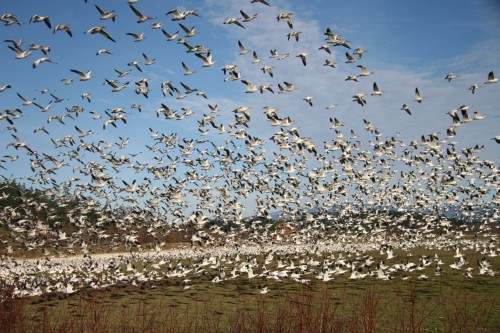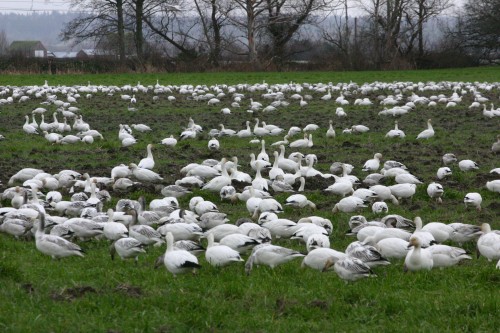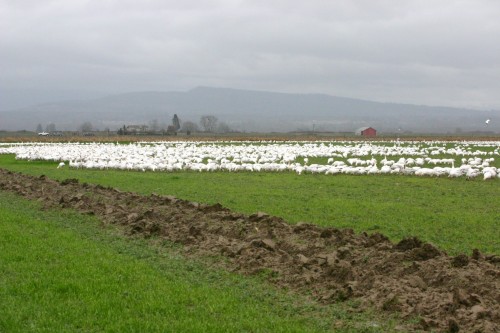Winter Treasures of the Skagit Valley

There’s a sense of amazement that overcomes me each winter when I approach a muddy farm field turned white. It’s not from snow, per se, but snow geese, who travel hundreds of miles from their Siberian nesting grounds to winter and feed in the lower Skagit Valley. The fields this time of year, particularly near Fir Island, come alive with a buzz of honks and squawks as flocks numbering in the thousands cover the landscape and fill the sky as they come and go.
“Thousands of snow geese taking off from a field is one of the most spectacular sights one can imagine,” says Howard Armstrong, a Skagit Audubon member who has birded in the Skagit Valley for 40 years.

Top: An enormous flock of snow geese is a common sight during the winter months in the Skagit Valley. Photo by Christian Martin. Above:Â Snow geese return to the large farm fields in Skagit each year to feed on cover crops. Photo by Codi Hamblin.
Snow geese migrate to Skagit County each winter from their Arctic breeding grounds of summer. Photo by Codi Hamblin.
But snow geese are only one of several species who winter in Skagit County. Other birds include the thousands of trumpeter and tundra swans who leave their boreal and arctic pond breeding grounds in Alaska and Canada to feed on the open crop fields. The trumpeter swan, Howard says, was nearly extinct at the turn of the 21st Century, but this largest of north american waterfowl can now be seen in the Skagit Valley.
Tundra and trumpeter swans are another species seen feeding in farm fields throughout Skagit County. Photo by Kelsi Franzen.
Trumpeter swans are the largest North American waterfowl. They return to Skagit County each year from their summer breeding grounds in Alaska and Canada. Photo by Kelsi Franzen.
Red-tailed hawk is one of four raptor species in Skagit County during the winter, in addition to five falcon species. Photo by Kelsi Franzen.
Bald eagles from Alaska and Canada, who migrate to the Skagit River to feed on spawned out chum salmon, also comprise this unique winter list, as well as various species of shore birds and multiple raptor species. This diverse array of wintering birds, combined with views of the Samish and Skagit flats, Skagit River and Olympic and Cascade Mountains, makes the valley a popular destination for birders of all levels.
“Winter is really the special time of year to bird in the Skagit and Samish valleys,” Howard says. “We have more species during spring and summer, but the species that make our area special are here in winter.”
Join Howard for a day-long birding excursion, Winter Wings: Birding the Skagit and Samish Flats. Using binoculars, scopes and field guides, participants will receive a close look at snow geese, trumpeter and tundra swans, short-eared owls, bald eagles, flocks of shorebirds and possibly five different species of falcons, as well as gain strategies for identifying these winter species!



Thanks Howard for this reminder of this special time in Skagit Valley. It will be a good excuse to travel that direction and see them-great photos Kelsi!
You live in the very best place in the country, hands down!